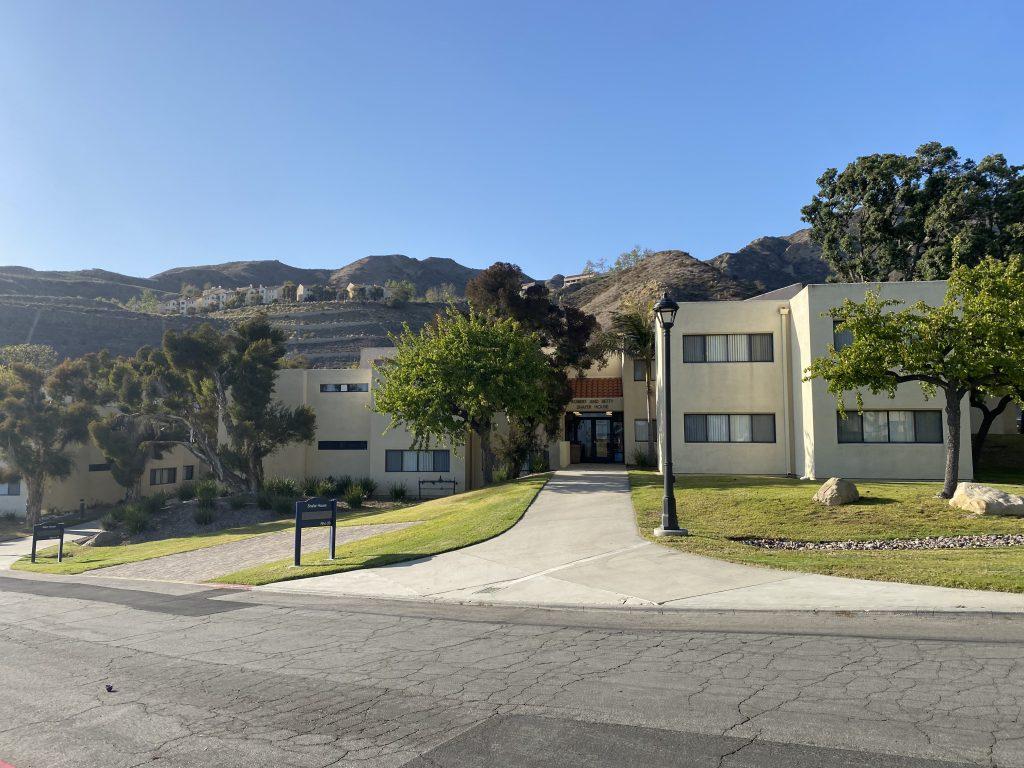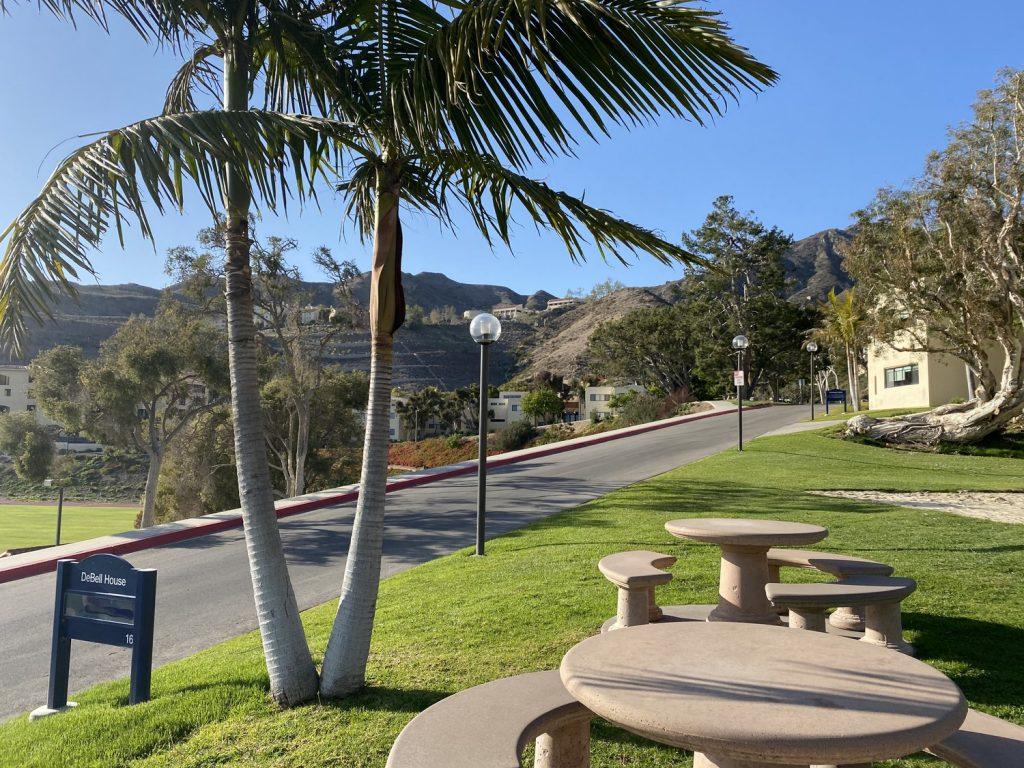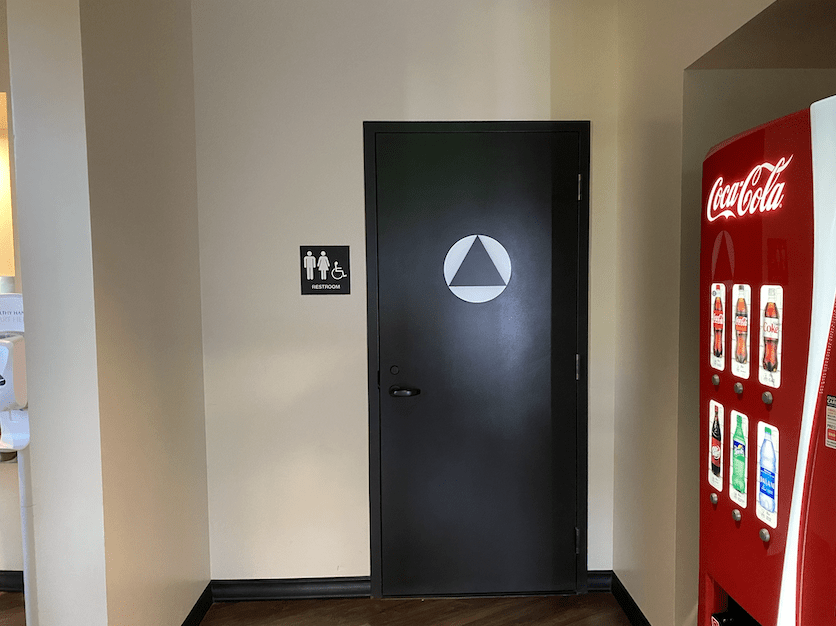
Editor’s note: *Name has been changed to protect the individuals’ privacy due to gender identity.
Greek Row residence halls sit empty in spring 2021. Pepperdine Housing and Residence Life places students in residence halls based on their sex, not gender identity. Photo by Ashley Mowreader
Pepperdine has a history of gender-based separation on campus, with a ban on the opposite sex in dorms at the Los Angeles campus. The University first introduced gender-mixed floors in 2012 to mirror the abroad experience, according to past Graphic reporting.
But despite changes, housing assignments and restrooms available on campus remain challenges in inclusion for transgender or gender queer students on campus.
“You really have to go through the effort of making your own space,” senior non-binary Seaver student Miller said. “If I want to really feel affirmed in my gender, while I have plenty of affirming cisgender friends, I do like to seek out the company of other trans people [and] build that space myself. But there’s not a physical space for that.”
Housing
Pepperdine does not provide non-gendered housing on the Malibu campus — all room and suite assignments, as well as placement in suite-style residence halls like the first-year dorms, consider a student’s sex.

Miller lives with women in on-campus housing, something they said is fine, but not representative of their identity.
“It’s just been odd knowing men and other non-binary people that I would feel perfectly comfortable living with, but I know that I have to find people that the University will read as women to live with,” Miller said. “And that’s just a time when I am more conscious of the ways that people in authority will see me.”
J. Doe*, a first-year non-binary Seaver student, said they live with men in a first-year residence hall and have found their situation comfortable, despite having some fears at the beginning.
“I was concerned that, arriving on campus, being in a living community of a bunch of guys and being singled out or having a difficult time connecting with people,” Doe said. “[But] I felt fairly welcome, like I feel comfortable putting my pronouns and my username on my GroupMe for my dorm building.”
Housing and Residence Life uses an individual approach to accommodate transgender students, wrote Brittany Skinner, assistant dean of Student Affairs and director of Student Activities, in a March 25 email to the Graphic.
“Our goal is to respect the needs of our students with an understanding that needs and wishes vary for each individual,” Skinner wrote. “We start by listening, knowing we can best serve our transgender and gender non-conforming students by hearing their requests for their living situation. From those conversations, we make arrangements that, to the greatest extent we can, make them feel supported and comfortable.”
Miller said they did not seek accommodations from the University regarding housing placements due to privacy concerns.
“I haven’t sought that out, mainly because I didn’t know how that would work and also because I was unsure whether that could get back to my parents,” Miller said. “Or if my parents asked me about my roommates, and I have an unusual situation that could raise questions that I’m not ready to answer to them yet.”
If the school does accommodate gender queer students, Miller said that information was not communicated to them nor seems readily available.
“It’s tough to know that these spaces are not made with me in mind,” Miller said. “They’re made for other people. And you really have to go through the effort of making your own space.”
In her statement to the Graphic, Skinner did not provide specific examples of housing accommodations the University provides for trans or non-binary students.
Restrooms
For non-binary or gender queer community members, navigating which restroom to use is a daily struggle.
“Bathrooms are something that is on my mind more than it needs to be on most people’s mind,” Miller said.
On the Malibu campus, there is generally at least one set of gendered, public, multi-stall restrooms on every floor of every public building, wrote Jeff Gin, associate director of Planning, Operations and Construction, in a March 24 email to the Graphic.
Miller said they generally use women’s restrooms on campus, as they pass more feminine than masculine, but their preference is single-use or all gender restrooms.
“There is one family bathroom that I know of on campus, in the Seaside lobby,” Miller said. “Since I’ve found out about that family bathroom, I use it whenever I have the opportunity whenever I’m down in Seaside, because it seems like such a little thing, but it just feels nice to go to the bathroom and not feel like I’m performing anything.”

The Department of Planning, Operations and Construction provided the Graphic with a document outlining all single-use bathrooms on record, their location and dimensions.
There are 57 single-use restrooms on the Malibu campus, according to the document — 28 of which are located within student housing.
An interactive map of single-use restrooms on campus, according to documents from the Department of Planning, Operations and Construction. Infographic by Ashley Mowreader
Each first-year residence hall has a single-use restroom on the first floor, Seaside Residence Hall has a single-use restroom outside its fitness center — the one Miller uses — and Towers Residence Hall houses the other 12 bathrooms. Only residents within the residence halls have access to floors with the bathrooms.
Of the remaining 29 bathrooms, 17 are in office spaces such as the Department of Public Safety or the Drescher Central Plant.
The largest single-use bathroom on campus is for private use in the Thornton Administrative Center on the fourth floor in the Office of the President.
There is also a lack of single-use restrooms at other event spaces including Payson Library, Firestone Fieldhouse, Ralph-Straus Tennis Center, Elkins Auditorium, the Weisman Museum and Smothers Theatre.
Classrooms are also absent of single-use restrooms — the RAC, AC, BPC, CAC, Keck Science Center, the Music Building, Pendleton Learning Center all lack single-use or family bathroom facilities. Athletic bathroom facilities are also gendered — locker rooms, the athletic training room and Heritage Hall bathrooms are all multi-stall gendered restrooms.
“I have always been a big fan of either single-user or gender-neutral bathrooms especially on something like a college campus where most of the people that are using it go to school here,” Doe said.
Doe said they are familiar with gender-neutral restrooms near their hometown of Portland, but Miller said they had only seen one gender-neutral restroom at a restaurant in Los Angeles.
“I can understand the concern, especially if it’s something that you’re not familiar with,” Doe said. “But I’m yet to meet anyone who’s had that experience, specifically in a gender-neutral bathroom.”
Miller said they hope, moving forward, Pepperdine and its community will be more accommodating for students in physical spaces.
“It’s not so much about making new spaces that are for trans and non-binary people — we’re not trying to set up a third gendered space,” Miller said. “It’s about removing barriers and making places that are for everyone. And right now, there are a lot of places that are designed to not be for everyone, and it doesn’t need to be that way.”
_________________________________
Follow the Graphic on Twitter: @PeppGraphic
Contact Ashley Mowreader via Twitter (@amowreader) or by email: ashley.mowreader@pepperdine.edu

